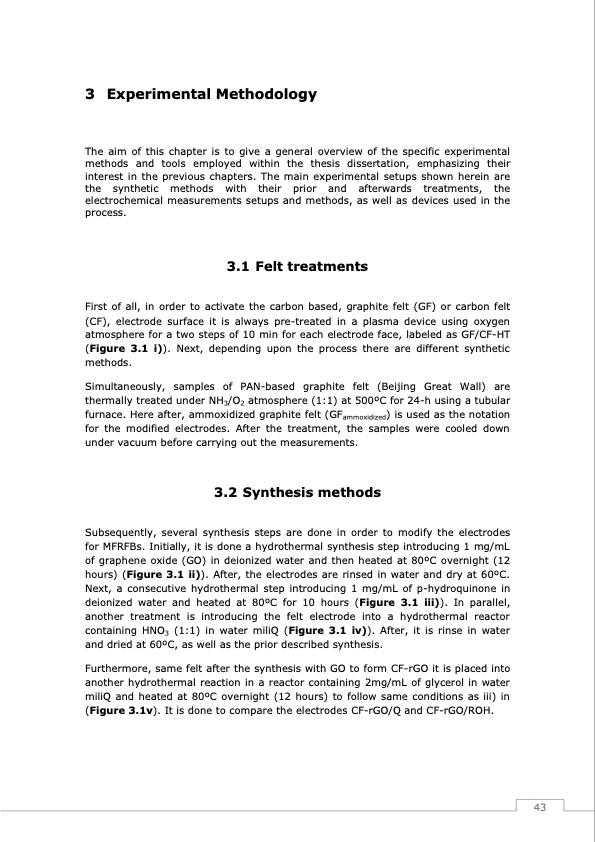
PDF Publication Title:
Text from PDF Page: 044
3 Experimental Methodology The aim of this chapter is to give a general overview of the specific experimental methods and tools employed within the thesis dissertation, emphasizing their interest in the previous chapters. The main experimental setups shown herein are the synthetic methods with their prior and afterwards treatments, the electrochemical measurements setups and methods, as well as devices used in the process. 3.1 Felt treatments First of all, in order to activate the carbon based, graphite felt (GF) or carbon felt (CF), electrode surface it is always pre-treated in a plasma device using oxygen atmosphere for a two steps of 10 min for each electrode face, labeled as GF/CF-HT (Figure 3.1 i)). Next, depending upon the process there are different synthetic methods. Simultaneously, samples of PAN-based graphite felt (Beijing Great Wall) are thermally treated under NH3/O2 atmosphere (1:1) at 500oC for 24-h using a tubular furnace. Here after, ammoxidized graphite felt (GFammoxidized) is used as the notation for the modified electrodes. After the treatment, the samples were cooled down under vacuum before carrying out the measurements. 3.2 Synthesis methods Subsequently, several synthesis steps are done in order to modify the electrodes for MFRFBs. Initially, it is done a hydrothermal synthesis step introducing 1 mg/mL of graphene oxide (GO) in deionized water and then heated at 80oC overnight (12 hours) (Figure 3.1 ii)). After, the electrodes are rinsed in water and dry at 60oC. Next, a consecutive hydrothermal step introducing 1 mg/mL of p-hydroquinone in deionized water and heated at 80oC for 10 hours (Figure 3.1 iii)). In parallel, another treatment is introducing the felt electrode into a hydrothermal reactor containing HNO3 (1:1) in water miliQ (Figure 3.1 iv)). After, it is rinse in water and dried at 60oC, as well as the prior described synthesis. Furthermore, same felt after the synthesis with GO to form CF-rGO it is placed into another hydrothermal reaction in a reactor containing 2mg/mL of glycerol in water miliQ and heated at 80oC overnight (12 hours) to follow same conditions as iii) in (Figure 3.1v). It is done to compare the electrodes CF-rGO/Q and CF-rGO/ROH. 43PDF Image | Redox Flow Batteries Vanadium to Earth Quinones

PDF Search Title:
Redox Flow Batteries Vanadium to Earth QuinonesOriginal File Name Searched:
FJVG_TESIS.pdfDIY PDF Search: Google It | Yahoo | Bing
Salgenx Redox Flow Battery Technology: Salt water flow battery technology with low cost and great energy density that can be used for power storage and thermal storage. Let us de-risk your production using our license. Our aqueous flow battery is less cost than Tesla Megapack and available faster. Redox flow battery. No membrane needed like with Vanadium, or Bromine. Salgenx flow battery
| CONTACT TEL: 608-238-6001 Email: greg@salgenx.com | RSS | AMP |